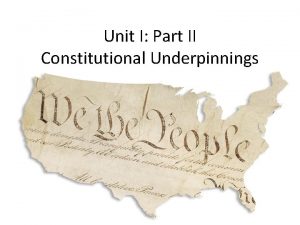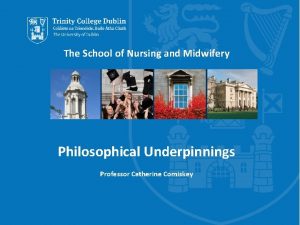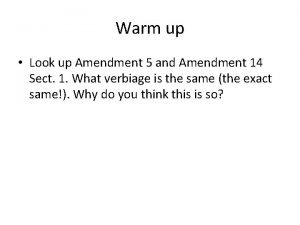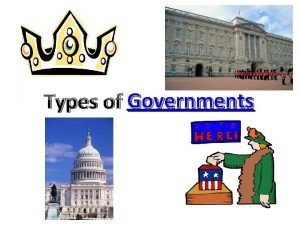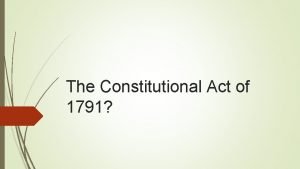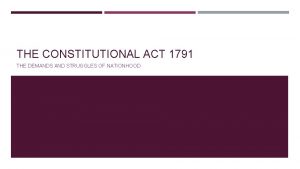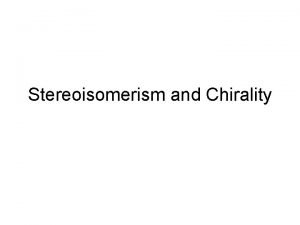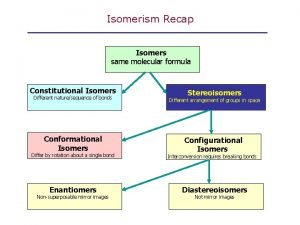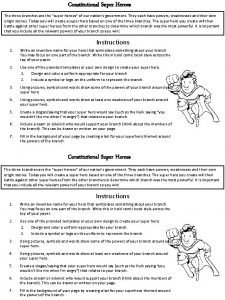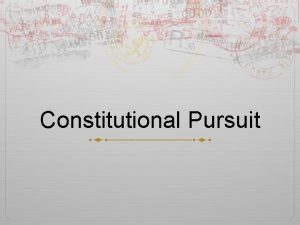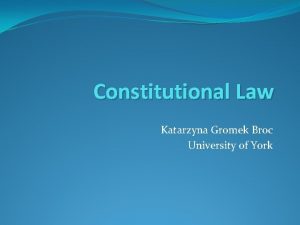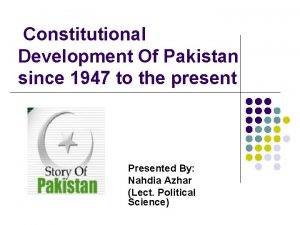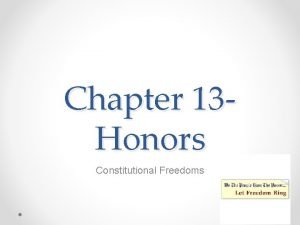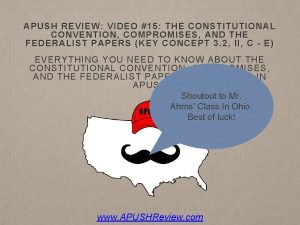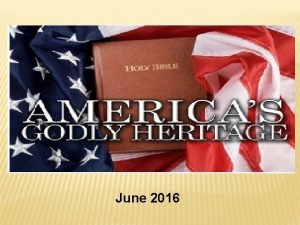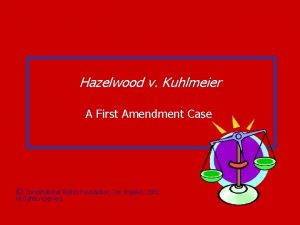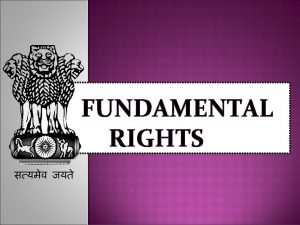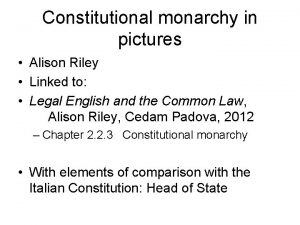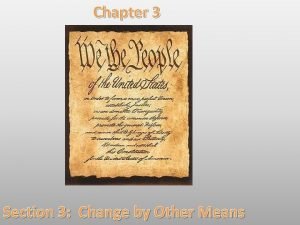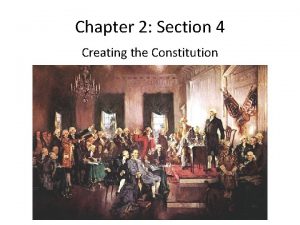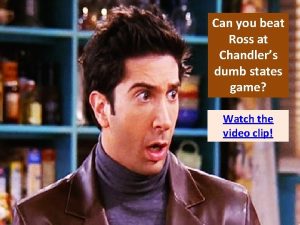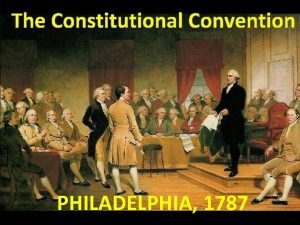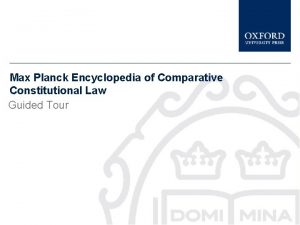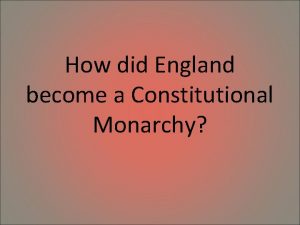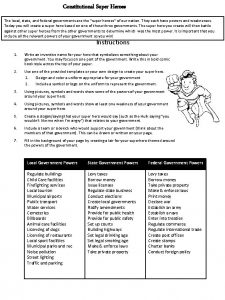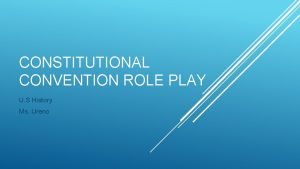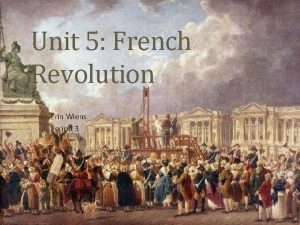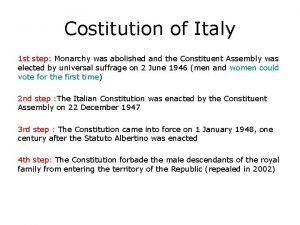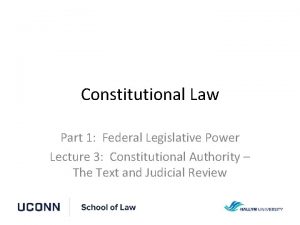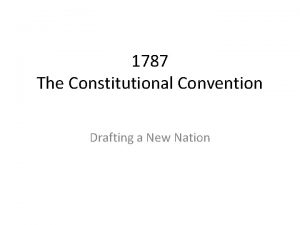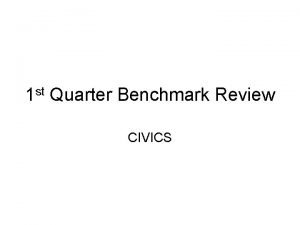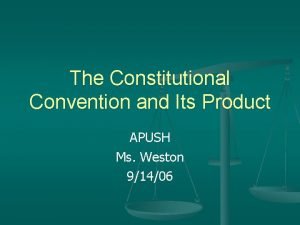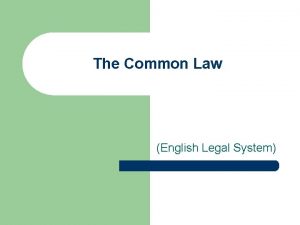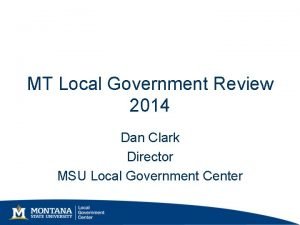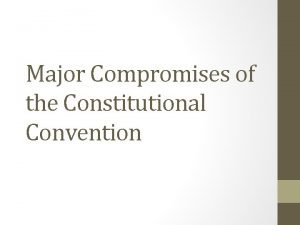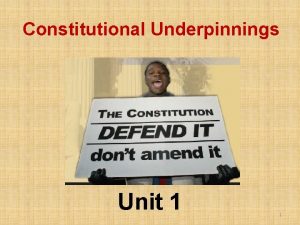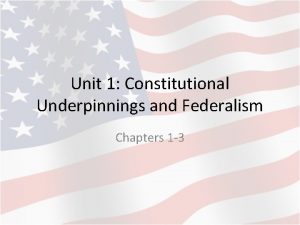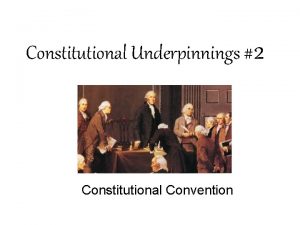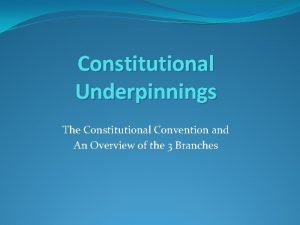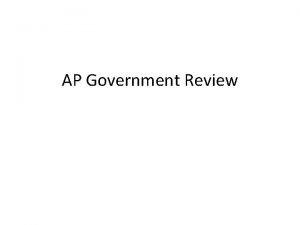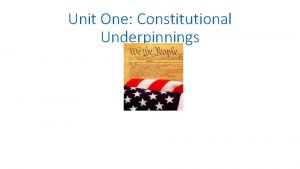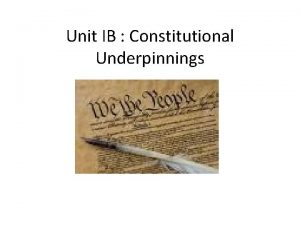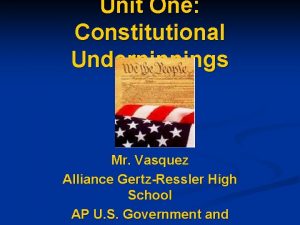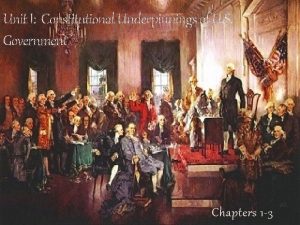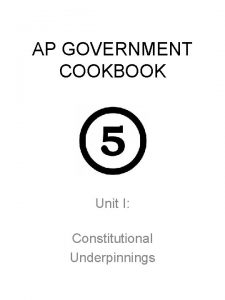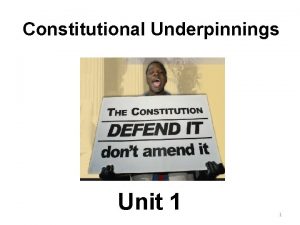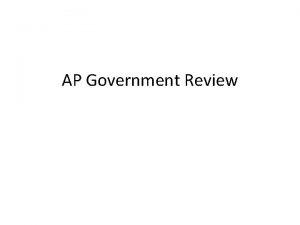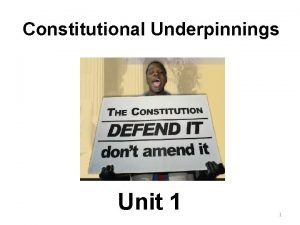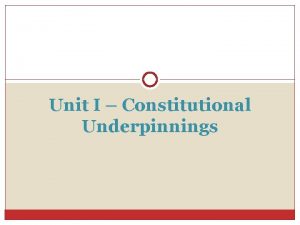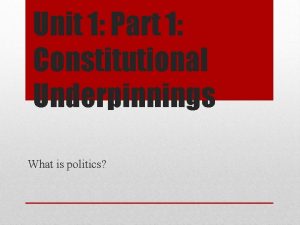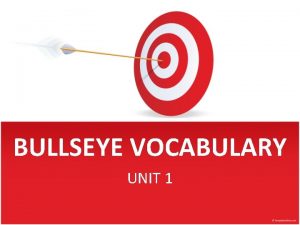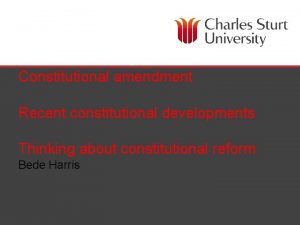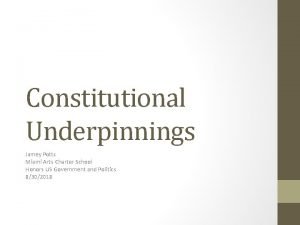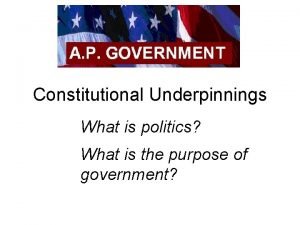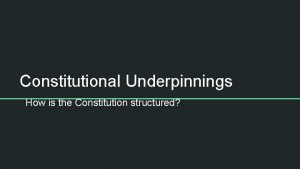Unit 1 Chapters 1 3 Constitutional Underpinnings of








































- Slides: 40

Unit 1 - Chapters 1 -3 Constitutional Underpinnings of the US Government and Federalism

Why does politics matter? What are some ways that government affects you? Public schools Driving, drinking, voting ages Taxes (Sales, income, Social Security) STUDENT LOANS!!! Anti-discrimination laws

1. 1. Government Identify the key functions of government and explain why they matter. Government- institutions that make public policy for a society Congress, President, Courts, Federal agencies (“Bureaucracy”)

Purposes of National Govt. Maintain a national defense Provide public goods and services Preserve order Socialize the young Collect taxes

1. 2 Politics Define politics in the context of a democratic government. Politics determines whom we select as leaders and what policies they pursue “Who gets what, when, and how”

Political Participation US has one of the lowest voter turnouts in the world. Groups with a high turnout benefit (elderly) Single-issue groups- base votes on only one issue Ex: Abortion, gun rights

1. 3 Policymaking The process by which people’s interests and problems create political issues for government policymakers Figure 1. 4 Linkage institutions- parties, elections, interest groups that transmit Americans’ preferences to the policymakers in government Policymaking institutions- President, Congress, Courts, Bureaucracy Table 1. 1 Examples of Public Policies

1. 4 Democracy A system of selecting policymakers and organizing government so that it reflects citizens’ preferences Dahl’s five criteria for Democracy Equality in voting Effective Participation Enlightened understanding Citizen control of the agenda Inclusion

Theories of American Democracy Pluralism- theory that the policymaking process is open to all groups with shared interests, with no single group dominating Elitism- theory that an upper-class elite holds the power and makes policy, regardless of formal government organization Hyperpluralism- theory that groups are so strong that government is weakened. Government gives in to interest and single-issue groups.

American Political Culture Liberty Egalitarianism Individualism Laissez-faire Populism

Chapter 2 - The Constitution

Constitution The nation’s basic law Creates institutions, allocates power, provides guarantees to citizens

English Heritage John Locke- Second Treatise of Civil Government 1689 - humans have natural rights, not dependent on governments Life, liberty, property Superior to manmade law Consent of the governed Purpose of government is to protect natural rights People have a right to revolt against a government that no longer has their consent Table 2. 1 Locke and Jefferson

Declaration of Independence (1776) People should rule instead of being ruled. “created equal” “unalienable rights” Consent of the governed, not divine right

Articles of Confederation (1776 -1787) No president, no national court, one house legislature Authority rested with states National government could not compel states to do anything Could not regulate commerce, form an army

Constitutional Convention (1787) Who? Wealthy planters, lawyers, merchants, men of wealth, college graduates, urban Factions- groups that arise from unequal distribution of property or wealth Madison claimed that one faction would eventually tyrannize another Wanted to limit power of factions (groups) Checks and balances- separate branches with defined powers

Madisonian System Feared factions(minority or majority) taking control of government Limiting Majority Control- only House is directly elected Senate was elected by state legislatures Electors choose President Judges appointed for life Senate 6 year terms, House 2 years

Madisonian System Separating Powers- each branch is relatively independent Powers are shared Checks and balances- to constrain government action (Figure 2. 4) President has veto power, Congress controls money, approves nominations Marbury v. Madison- Judicial review- Supreme Court can hold actions of other two branches as unconstitutional

Federalists vs. Anti. Federalists 9 of 13 states had to approve Constitution Federalists- supporters of Constitution Federalist Papers- Written by James Madison, Alexander Hamilton, John Jay Figure 2. 5 Comparison of Federalists and Anti. Federalists AF feared a class-based democracy ruled by the elite. There was no protection of individual rights in Constitution

Bill of Rights Added to protect individual liberties First 10 amendments Table 2. 6

Changing the Constitution Figure 2. 5. 2/3 of both houses ¾ of state legislatures President has no formal role Has led to more democratic, egalitarian, expanded liberty Difficult to amend

Informal Amending Judicial Review- power of courts to determine whether acts of President or Congress are constitutional Established by Marbury v. Madison Example: separate but equal Changing political practice- political parties, electors Tradition (the ways it’s been done)

Flexibility of Constitution is relatively short. Framers intended to create a flexible system that can adapt to needs of the times. The oldest functioning constitution

CHAPTER 3 FEDERALISM

Federalism Two or more levels of government have formal authority over the same area and people. Ex: Olive Branch, Desoto County, Mississippi, USA Unitary- all power is in the central government (most nations) States receive authority directly from Constitution. Table 3. 1 - Three forms of government

Division of Power Constitution does not define powers of state governments. Constitution is specific about what states cannot do: Ex: tax imports, coin money, grant titles of nobility, deny equal protection, declare war, etc. Table 3. 2

National Supremacy Should state or federal government regulate marriage, abortion, highways, minimum wage, etc? SUPREMACY CLAUSE- article VI. “This Constitution, and the laws of the United States which shall be made in pursuance thereof; and all treaties made, or which shall be made, under the authority of the United States, shall be the supreme law of the land” Constitution, laws of national government, treaties are the supreme law of the land.

Conflicts Between State and Federal Laws Civil War- national government asserted power over states Civil Rights/Integration Tenth Amendment- “powers not delegated to the United States by the Constitution, nor prohibited by it to the states, are reserved to the states respectively, or to the people. ” Used by states’ rights advocates Federal government only has those powers specifically assigned to it.

Implied Powers Mc. Culloch v. Maryland 1819 - American government had created a national bank. Maryland passed a law taxing the bank. The bank refused to pay. Supreme Court ruled: 1. Federal law is supreme over state law. 2. Congress has the right to “make all laws necessary and proper for executing the foregoing powers”

Enumerated and Implied Powers Enumerated- powers specifically addressed in the Constitution Ex: coining money, imposing taxes Implied powers- go beyond enumerated “Necessary and proper” clause AKA “elastic clause” Examples: regulate food and drugs, build highways, protect consumers

Commerce Power Congress has the power to regulate commerce. (Article I, Section 8) Gibbons v. Ogden- 1824 - interpreted Section 8 broadly and allowed Congress to regulate virtually every form of commercial activity Originally blocked many New Deal programs, used to justify bans on discrimination in movie theaters, etc. Read cases at bottom of page 82 for examples.

States’ Relationships with Each Other Full faith and credit clause- Article IV- each state must recognize the public acts, records, and judicial proceedings of all other states Ex: drivers and marriage licenses are valid Defense of Marriage Act- 1996 - permitted states to disregard gay marriages that occurred in another state Struck down by Supreme Court for denying “equal protection”

Privileges and Immunities Citizens of each state have privileges of other states It’s complicated. The more fundamental the right, the less likely a state can discriminate against a citizen of another. For example: out of state tuition, taxes on hotel rooms for tourists Owning property, police protection- cannot be discriminated

Dual vs. Cooperative Federalism Dual Federalism- both state and national government remain supreme in their own spheres National government is responsible for some policies, states for others Layer cake model Cooperative Federalism- power and policy are shared by states and national government Marble cake model (our current system)

Cooperative Federalism at Work Usually thought of as local responsibility Land grant colleges, Elementary and Secondary Education Act, National Defense Education Act, No Child Left Behind Act Construction of highways Shared costs, Federal Guidelines, and Shared Administration Drinking Age- page 87

Fiscal Federalism Federal government uses funds appropriated by Congress to influence state and local governments Figure 3. 1 page 89 Federal aid accounts for ¼ of funds spent by state and local governments

Types of Grants Categorical grants: can only be used for specific purposes or “categories” Have conditions attached (nondiscrimination) Project grants: awarded by competitive applications Formula grants: distributed based on a formula Medicaid, child nutrition, public housing, etc. Block Grants- give states broad discretion in how they are spent

Mandates Congress may require states to expand a program to keep receiving aid Congress may or may not fund the increase Example: Medicaid- Congress has pushed to extend coverage, but has not provided enough funds Americans with Disabilities Act/Clean Air Actrequired states to implement but did not fund

Federalism and Democracy Founders established a federal system to allay fears of a tyrannical, distant central government. Allows states to look out for their own interests Ex: energy in Texas, citrus in Florida Provides more opportunities to participate in politics Local, state elections Table 3. 3 Page 97 - Number of Governments in America

 Types of federalism
Types of federalism Philosophical underpinnings of nursing
Philosophical underpinnings of nursing Unit 6 review questions
Unit 6 review questions Gitlow v new york constitutional question
Gitlow v new york constitutional question Who governs a dictatorship
Who governs a dictatorship Constitutional act of 1791
Constitutional act of 1791 Constitutional act of 1791
Constitutional act of 1791 Constitutional isomer
Constitutional isomer Right to constitutional remedies
Right to constitutional remedies 2-methylpentane structural isomerism
2-methylpentane structural isomerism Stereoisomer vs constitutional isomer
Stereoisomer vs constitutional isomer Legislative branch superhero names
Legislative branch superhero names Constitutional pursuit answer sheet
Constitutional pursuit answer sheet Constitutional law definition
Constitutional law definition Constitutional development in pakistan from 1947 to 1973
Constitutional development in pakistan from 1947 to 1973 Gitlow v new york constitutional question
Gitlow v new york constitutional question Constitutional convention apush
Constitutional convention apush 5 isomers of hexane
5 isomers of hexane Constitutional convention 1787
Constitutional convention 1787 Hazelwood v. kuhlmeier summary
Hazelwood v. kuhlmeier summary Right to constitutional remedies article 32 to 35
Right to constitutional remedies article 32 to 35 Constitutional monarchy pictures
Constitutional monarchy pictures Chapter 3 section 3 change by other means worksheet answers
Chapter 3 section 3 change by other means worksheet answers Chapter 2 section 4 creating the constitution
Chapter 2 section 4 creating the constitution Chandler's states game
Chandler's states game Constitutional convention compromise
Constitutional convention compromise Max planck encyclopedia of comparative constitutional law
Max planck encyclopedia of comparative constitutional law When did england become a constitutional monarchy
When did england become a constitutional monarchy Constitutional convention compromise
Constitutional convention compromise Constitutional superheroes examples
Constitutional superheroes examples Constitutional convention role play
Constitutional convention role play 3/5 compromise cartoon
3/5 compromise cartoon France constitutional monarchy
France constitutional monarchy Constitutional republic symbol
Constitutional republic symbol Constitutional power
Constitutional power Constitutional convention
Constitutional convention Characteristics of constitutional democracy
Characteristics of constitutional democracy Constitutional convention apush
Constitutional convention apush Equity legal definition
Equity legal definition Constitutional powers
Constitutional powers Compromises at the constitutional convention
Compromises at the constitutional convention
